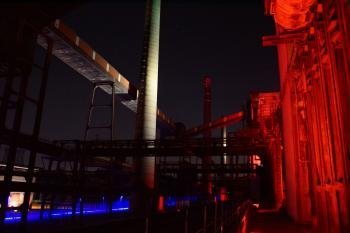
The Zollverein coal mine is always described with superlatives: “the most beautiful coal mine of the world” or “the largest coking plant in Europe”. Absolutely justified, the complex fascinates by its size and by the combination of powerful technology and extraordinary architecture. The WHS comprises three parts: the founding shaft 1/2/8, the shaft XII complex, and the coking plant. Coal mining at Zollverein began in 1847. In the following decades an industrial landscape of several connected pits emerged. At the beginning of the 1920s, the mine was no longer profitable and not further expandable. Thus, the owners decided to combine the facilities and to construct a new high-tech plant: Shaft XII.
The special feature of Shaft XII is that all buildings were constructed according to a consistent architectural concept. In only four years, from 1928 to 1932, twenty cubic buildings were constructed inspired by the Bauhaus style. The buildings consist of steel frameworks and self-supporting curtain façades made of red brick. They not only looked good, they were also extraordinarily practical. The purpose of the individual buildings is not visible from the outside, the whole plant forms a functional and aesthetic unit.
Like most visitors, we entered Zollverein at the so-called “Court of Honour" with the iconic headframe. The view is still as impressive as it probably was 80 years ago. We first went to the visitor centre in the former coal washing plant, visitors enter the building at the upper level via a modern escalator. Various guided tours are available, we took the "path of coal" tour, highly recommended. The guide explained the production processes of the coal: the separation of rock and coal, the sorting into different quality categories, the loading onto wagons, we have seen the conveyor belts, shaking screens, the tipper house etc. From the roof you have a beautiful view over the whole plant and the surrounding landscape. The coal washing plant also houses the Ruhr Museum. Its newly built, orange illuminated staircase is worth seeing. The museum shows the natural and cultural history of the Ruhr area, it does not refer specifically to the World Heritage site. We did only a short tour through the exhibition, a lunch break seemed more attractive, but the exhibition is very extensive and surely deserves more attention. Unfortunately, the information panels are in German only.
Worth seeing is the Red Dot Design Museum in the former boiler house. The three-wing complex is one of the most impressive buildings of the mine. When you walk towards the entrance, the whole scenery reminds of a palace or castle – but with straight lines and cubic shapes without any ornament or decoration. Inside, one of the five huge boilers has been preserved, the others were opened and exhibition floors were installed. The museum presents contemporary product design: household objects, furniture, sports equipment, watches, etc. I liked very much this unusual combination of industrial heritage and modern design objects.
The coking plant is the largest of the three parts and looks like what one would expect from an industrial site. The central part is the long row of more than 300 furnaces. Here the coal was baked to high-quality coke. The plant was operated from 1961 to 1993, now nature recaptures the territory. Grass, flowers and bushes are growing between the rotting installations and offer interesting views. Obviously there are also some rare species, because you can even book botanical tours.
We spent the whole day at Zollverein, there is a lot to see. After a very good dinner at the Casino Zollverein we finished our visit with a stroll around shaft XII and the coking plant (the whole area is free accessible). At night, the coking plant is illuminated with red and blue lights and offers a very special and spooky atmosphere.
Zollverein is not only a museum and tourist attraction but also a good example of successful structural change. It is also a cultural centre: there are theatre and dance performances, artist studios and workshops, exhibitions of contemporary art, rooms for congresses and conferences. There are plans for an extension of the Zollverein WHS. A proposal consisting of about 20 additional sites has been submitted for the upcoming new German T-list. With good chances, I think. In August 2012, I managed to visit all the proposed sites. Zollverein is certainly the most outstanding industrial site in the Ruhr area, but there are also other rewarding destinations. At least if one is interested in industrial heritage, it is worth to spend a few days in the Ruhr area.
More on
Comments
No comments yet.
